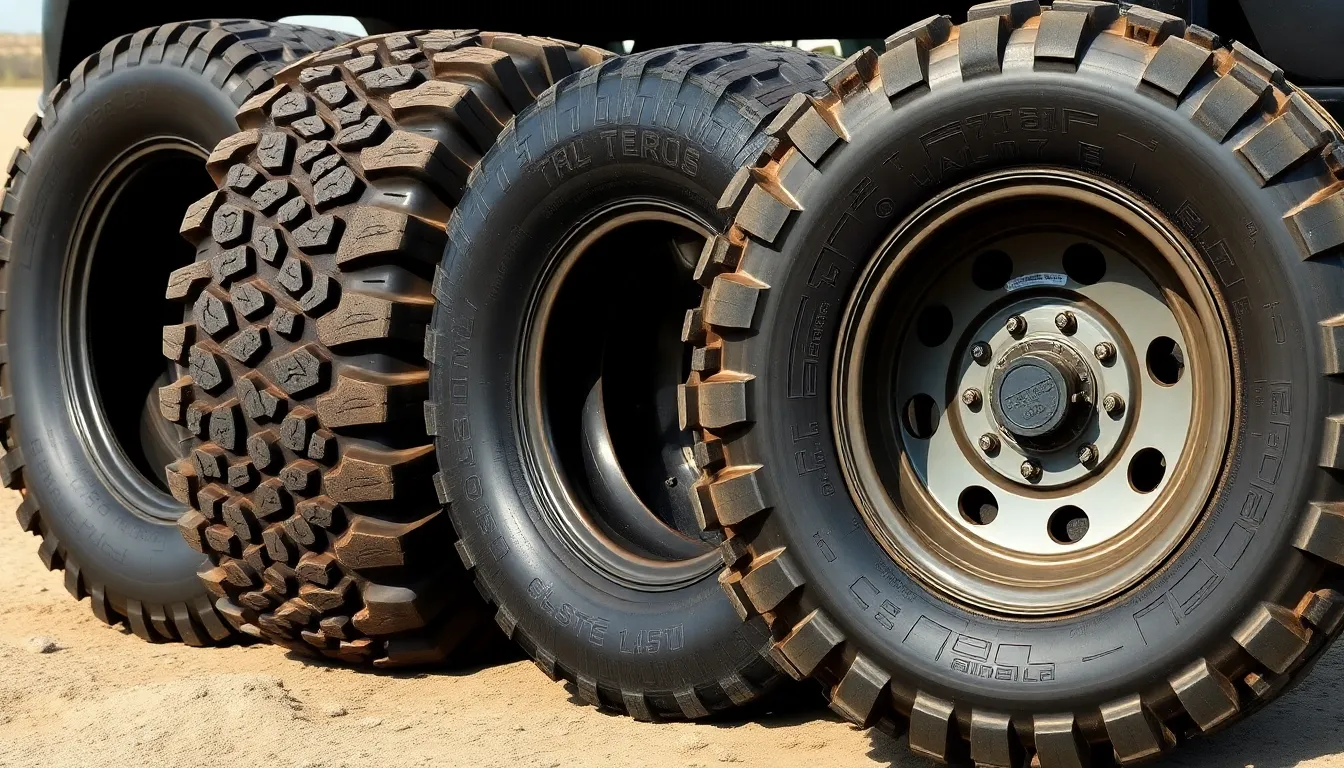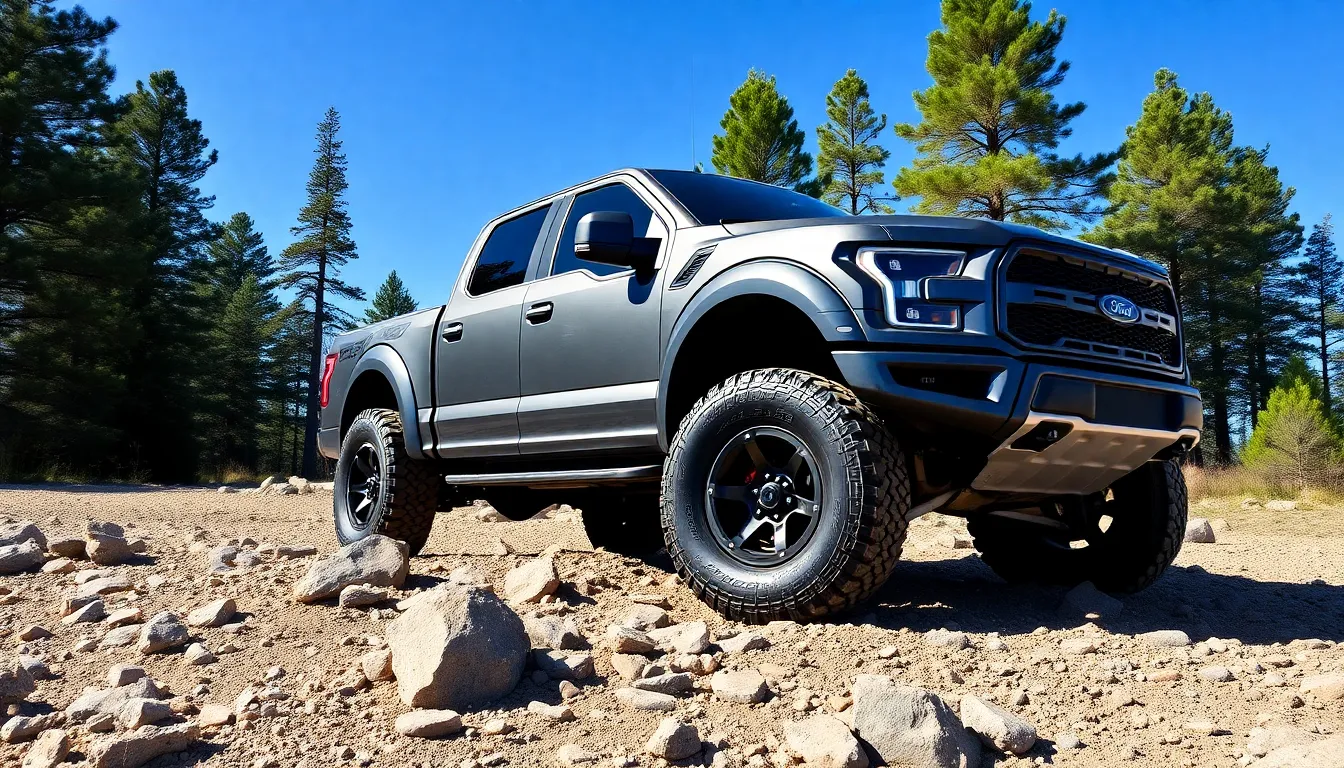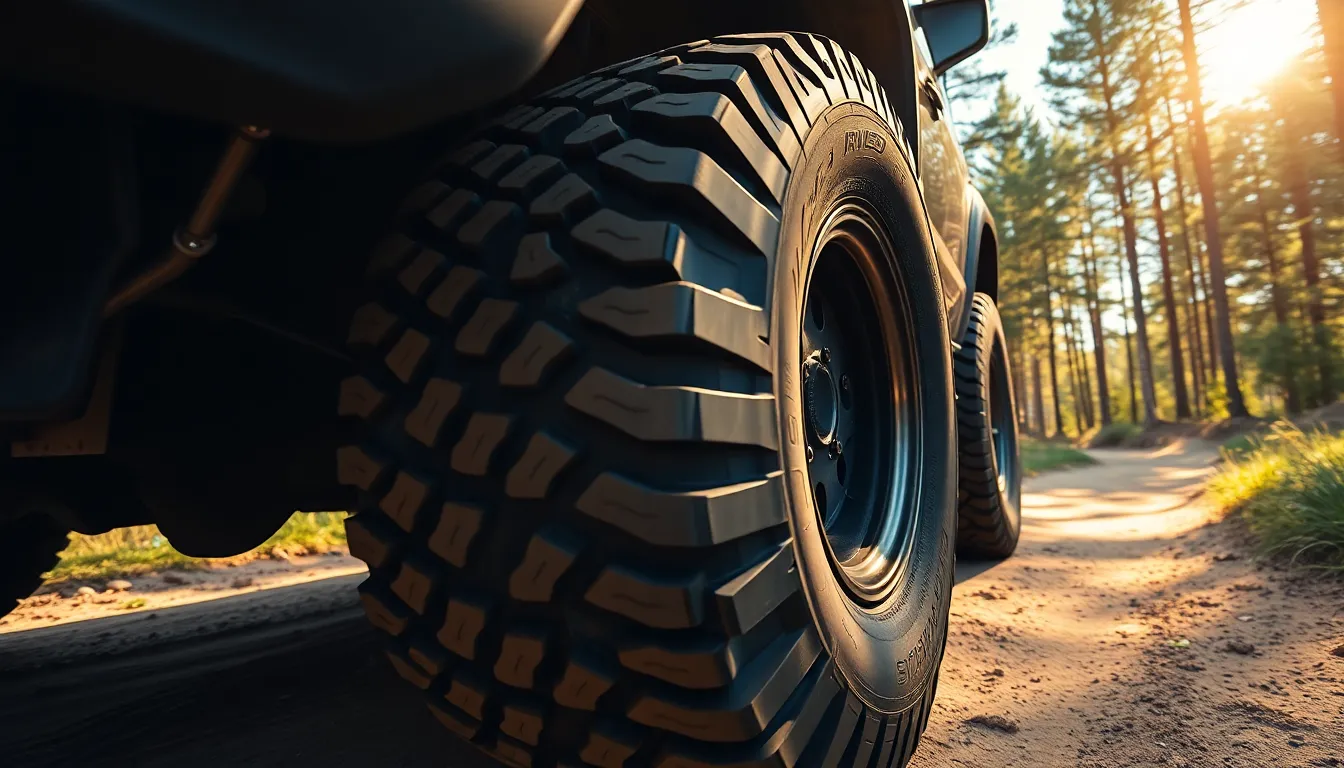When we’re shopping for new tires or planning a vehicle upgrade, understanding tire sizing becomes crucial for making the right choice. The term “33 tires” gets thrown around frequently in automotive circles, but what does it actually mean for your ride?
We’ve all been there – staring at confusing tire measurements and wondering how they translate to real-industry performance. The “33” designation refers to the tire’s overall diameter when mounted and inflated, measuring approximately 33 inches from top to bottom. This measurement significantly impacts your vehicle’s ground clearance, speedometer accuracy, and overall driving dynamics.
Whether you’re considering 33-inch tires for off-road adventures, improved aesthetics, or enhanced performance, we’ll break down everything you need to know about this popular tire size. Understanding these dimensions will help you make an well-informed choice that matches your driving needs and vehicle capabilities.
What Does “33 Inch Tires” Actually Mean?
The 33 inch designation refers to the tire’s overall diameter when properly mounted on a rim and inflated to manufacturer specifications. This measurement represents the distance from the top of the tire to the bottom, passing through the center point.
Tire manufacturers measure this diameter with the tire mounted on a standard wheel width and inflated to recommended pressure levels. The actual measurement can vary by 0.5 to 1 inch depending on the exact tire model, wheel width, and inflation pressure used during testing.
We find that 33 inch tires typically range from 32.5 to 33.5 inches in actual diameter across different brands and models. Popular examples include the BFGoodrich All Terrain T/A KO2 in 285/75R16 size, which measures approximately 32.8 inches, and the Nitto Ridge Grappler in 33×12.50R15, which measures closer to 33.2 inches.
| Tire Model | Size Designation | Actual Diameter |
|---|---|---|
| BFGoodrich KO2 | 285/75R16 | 32.8 inches |
| Nitto Ridge Grappler | 33×12.50R15 | 33.2 inches |
| Falken Wildpeak AT3W | 285/75R16 | 32.9 inches |
| Toyo Open Country AT3 | 33×12.50R17 | 33.0 inches |
Manufacturing tolerances explain why different tire brands produce slightly different actual diameters even though sharing the same 33 inch classification. Tread pattern design, sidewall construction, and rubber compound formulations all influence the final diameter measurement.
Load rating and speed rating don’t affect the diameter measurement but do impact the tire’s performance characteristics. These ratings appear on the tire sidewall alongside the size designation to provide complete specification information.
Common 33 Inch Tire Sizes and Specifications

Understanding the most popular 33-inch tire sizes helps drivers select the right option for their exact vehicle and driving requirements. Different sizing formats represent the same approximate 33-inch diameter while offering distinct performance characteristics.
285/75R16 – The Popular Choice
The 285/75R16 tire size represents one of the most common configurations for achieving a 33-inch diameter. This metric sizing format indicates a 285mm tread width and 75% sidewall aspect ratio mounted on a 16-inch rim.
Most 285/75R16 tires measure between 32.8 and 33.2 inches in actual diameter depending on the manufacturer and tread pattern. Popular models include the General Grabber AT/X at 32.9 inches and the Toyo Open Country A/T III at 33.0 inches.
This size fits many stock pickup trucks and SUVs without requiring suspension modifications. Factory wheel wells typically accommodate 285/75R16 tires on vehicles like the Ford F-150, Chevrolet Silverado 1500, and Toyota Tacoma.
305/70R16 – Wide and Aggressive
The 305/70R16 configuration delivers a wider contact patch with its 305mm tread width and 70% sidewall aspect ratio. This size creates an aggressive appearance while maintaining the 33-inch diameter standard.
Actual measurements for 305/70R16 tires range from 32.7 to 33.4 inches across different manufacturers. The BFGoodrich All-Terrain T/A KO2 measures 32.8 inches while the Nitto Trail Grappler reaches 33.2 inches in this size.
Wider tires provide improved traction in sand and loose terrain but may increase road noise and fuel consumption. Many enthusiasts prefer this size for its enhanced sidewall protection during rock crawling and trail driving.
33×12.50R15 – Classic Off-Road Size
The 33×12.50R15 represents traditional flotation sizing that directly states the tire’s intended dimensions. This format indicates a 33-inch diameter and 12.5-inch tread width mounted on a 15-inch rim.
Classic off-road tire models frequently use this sizing convention, with actual diameters typically measuring between 32.6 and 33.1 inches. The Mickey Thompson Baja MTZ P3 measures 32.8 inches while the Interco Super Swamper TSL/SX reaches 33.0 inches.
Flotation sizing remains popular among serious off-road enthusiasts who prioritize maximum sidewall flexibility and lower air pressure capabilities. The larger sidewall area provides better performance over rocks and obstacles compared to lower profile alternatives.
Measuring 33 Inch Tires: Height vs Actual Size

Measuring 33 inch tires reveals important differences between advertised height and actual dimensions. The nominal 33 inch designation serves as a marketing reference rather than an exact measurement you can expect when mounting the tire.
Actual tire height varies considerably from the 33 inch label. Most tires marketed as 33 inch measure between 32.2 and 33.8 inches in real industry applications. Manufacturing tolerances account for approximately 0.5 inches of variation in either direction from the stated size.
| Tire Size | Advertised Height | Actual Height Range | Variation |
|---|---|---|---|
| 285/75R16 | 33 inches | 32.8-33.4 inches | ±0.3 inches |
| 305/70R16 | 33 inches | 32.5-33.2 inches | ±0.4 inches |
| 33×12.50R15 | 33 inches | 32.2-33.8 inches | ±0.8 inches |
Height measurements depend on multiple factors beyond the tire construction itself. Wheel width affects the tire’s shape and overall diameter significantly. Mounting a 285/75R16 on an 8 inch wheel produces a different height than mounting it on a 9 inch wheel due to sidewall curvature changes.
Inflation pressure directly impacts tire height measurements. Under inflated tires compress and reduce overall diameter by 0.3 to 0.7 inches below specifications. Over inflation creates the opposite effect and can increase height by 0.2 to 0.4 inches above normal measurements.
Load bearing influences tire dimensions during operation. Carrying heavy loads compresses the tire and reduces effective diameter. The difference between unloaded and fully loaded measurements ranges from 0.5 to 1.2 inches depending on load capacity and tire construction.
Temperature affects tire dimensions through rubber expansion and air pressure changes. Hot tires expand and increase diameter by approximately 0.1 to 0.3 inches compared to cold measurements. Cold weather contracts the tire and reduces height by similar amounts.
Tread depth variations create additional measurement differences between new and worn tires. New tires with full tread depth measure 0.4 to 0.8 inches taller than worn tires approaching replacement time. This natural wear progression gradually reduces the effective rolling diameter throughout the tire’s service life.
Vehicles That Can Fit 33 Inch Tires

Many vehicles accommodate 33 inch tires either from the factory or with minimal modifications. Understanding which vehicles work best with these larger tires helps drivers make informed upgrade decisions.
Stock Applications
Full size pickup trucks dominate the list of vehicles that accept 33 inch tires without modifications. The Ford F-150 Raptor comes equipped with 315/70R17 tires measuring approximately 34.4 inches from the factory. Chevrolet Silverado 1500 Trail Boss models feature 275/65R18 tires that measure close to 32.1 inches.
Mid size trucks also accommodate 33 inch tires in many configurations. Toyota Tacoma TRD Pro models run 265/70R16 tires measuring 30.6 inches but easily upgrade to 285/75R16 options measuring 32.8 inches. Chevrolet Colorado ZR2 trucks come with 31 inch tires but accommodate 33 inch upgrades with proper wheel offset adjustments.
Large SUVs provide excellent platforms for 33 inch tire installations. Jeep Wrangler Unlimited models accept 285/70R17 tires measuring 32.7 inches with factory suspension geometry. Ford Bronco vehicles accommodate similar sizing with their robust suspension components and generous wheel well clearances.
Heavy duty pickup trucks offer the most clearance for oversized tires. Ford F-250 and F-350 Super Duty trucks accept 35 inch tires in many configurations. Chevrolet Silverado 2500HD and 3500HD models provide similar capabilities with their heavy duty suspension systems.
Modified Vehicles and Lift Requirements
Lifted vehicles expand 33 inch tire compatibility across many vehicle categories. Compact SUVs like the Jeep Grand Cherokee require 2 to 3 inch suspension lifts to accommodate 285/75R16 tires without rubbing issues. Honda Pilot and Toyota 4Runner models benefit from similar lift heights for proper 33 inch tire clearance.
Mid size sedans and crossovers demand more extensive modifications for 33 inch tire fitment. Subaru Outback vehicles require custom suspension work and important fender modifications to clear 285/70R17 tires. Toyota RAV4 models present similar challenges requiring professional installation expertise.
| Vehicle Category | Minimum Lift Required | Common Tire Size | Modifications Needed |
|---|---|---|---|
| Full Size Pickup | 0-2 inches | 285/75R16 | Wheel spacers |
| Mid Size Truck | 2-3 inches | 285/70R17 | Fender trimming |
| Large SUV | 1-2 inches | 305/70R16 | Bumper modifications |
| Compact SUV | 3-4 inches | 275/70R17 | Extensive bodywork |
Suspension lift kits enable 33 inch tire installations on vehicles with limited factory clearance. Body lift systems raise the vehicle frame 2 to 4 inches above the suspension components. Suspension lift kits modify spring rates and shock absorber lengths to accommodate larger tire diameters.
Wheel well modifications become necessary when installing 33 inch tires on vehicles with restrictive factory clearances. Fender rolling techniques reshape metal fender lips to prevent tire contact during suspension compression. Fender flare installations provide additional clearance while maintaining vehicle aesthetics and legal compliance requirements.
Performance Impact of 33 Inch Tires

Upgrading to 33-inch tires significantly alters vehicle performance characteristics across both paved and unpaved surfaces. These larger tires create measurable changes in acceleration, fuel economy, handling dynamics, and off-road capability that drivers experience immediately after installation.
On-Road Driving Characteristics
Acceleration performance decreases by approximately 8-12% with 33-inch tires compared to stock tire sizes due to increased rotational mass and reduced effective gearing. The additional weight requires more engine power to reach the same speeds, particularly noticeable during highway merging and uphill climbs.
Fuel economy typically drops by 1-3 miles per gallon depending on vehicle weight, engine size, and driving habits. Heavier tires create more rolling resistance, while the increased diameter changes the final drive ratio and forces engines to work harder at highway speeds.
Braking distances extend by 5-8 feet from 60 mph due to the increased rotational inertia and additional unsprung weight. Modern vehicles with ABS systems adapt to the change, but drivers must account for longer stopping requirements in emergency situations.
Highway noise levels increase noticeably with aggressive tread patterns designed for off-road use. All-terrain tires like the Toyo Open Country A/T III generate 3-5 decibels more road noise than stock highway tires, while mud-terrain options can add 6-10 decibels.
Speedometer readings become inaccurate by approximately 6-8% with most 33-inch tire installations. GPS devices show actual speed while dashboard speedometers read slower than reality, requiring recalibration or programming adjustments for accurate readings.
Off-Road Capabilities
Ground clearance increases by 1.5-2.5 inches with 33-inch tires, allowing vehicles to clear larger rocks, logs, and trail obstacles that would otherwise contact the differential or frame. This additional clearance proves essential for technical rock crawling and deep rut navigation.
Traction performance improves dramatically on loose surfaces like sand, mud, and gravel due to the larger contact patch and deeper tread blocks. Wider 33-inch tires like the 305/70R16 Nitto Trail Grappler provide 15-20% more surface contact area than stock tires.
Approach and departure angles remain unchanged since tire diameter affects ground clearance rather than bumper geometry. But, the increased diameter reduces breakover angle slightly as the tire extends further forward and rearward from the axle centerline.
Flotation characteristics enhance significantly in sand and snow conditions where the larger tire footprint distributes vehicle weight over a greater surface area. Beach driving and desert exploration become more manageable with reduced tire sinking and improved momentum maintenance.
Side-hill stability improves with the wider stance created by many 33-inch tire configurations. The increased track width and lower center of gravity relative to the contact patch provide better resistance to vehicle rollover on steep side slopes.
Rock crawling performance benefits from the larger diameter’s ability to bridge gaps between rocks and climb over obstacles that would trap smaller tires. The increased sidewall height also allows for lower air pressures, typically 8-12 PSI, which creates better tire conformity over irregular surfaces.
Choosing the Right 33 Inch Tire for Your Needs

Selecting the optimal 33-inch tire depends on your exact driving requirements and vehicle capabilities. Off-road enthusiasts benefit most from aggressive tread patterns like those found on the BFGoodrich All-Terrain T/A KO2, which provides excellent traction on rocky terrain and loose surfaces. Daily commuters prioritize highway comfort and fuel efficiency with options such as the Nitto Terra Grappler G2, offering quieter road performance while maintaining adequate off-road capability.
Load ratings directly impact tire selection for work trucks and heavy-duty applications. We recommend E-rated tires for vehicles carrying maximum payload capacity, while P-rated options suit lighter passenger vehicles. The 285/75R16 configuration works best for stock pickup trucks requiring minimal modifications, whereas the 305/70R16 size delivers improved ground contact for enhanced traction.
Tread pattern selection varies by primary use case:
- All-terrain treads excel in mixed driving conditions with balanced on-road comfort and off-road performance
- Mud-terrain patterns maximize traction in deep mud and soft sand but increase road noise significantly
- Highway treads optimize fuel economy and ride quality for predominantly paved surface driving
- Rock-crawling compounds feature reinforced sidewalls for extreme low-pressure applications
Budget considerations influence tire compound quality and expected lifespan. Premium manufacturers like Toyo and Falken offer extended treadwear warranties ranging from 50,000 to 65,000 miles, while economy brands typically provide 40,000-mile coverage. Installation costs increase $200-400 when suspension modifications become necessary for proper clearance.
Climate conditions affect compound selection for optimal performance year-round. Northern regions require tires with enhanced cold-weather flexibility, while southern areas benefit from heat-resistant compounds. The 33×12.50R15 size accommodates seasonal tire swapping more easily due to its compatibility with aftermarket wheel options.
Vehicle weight ratings determine appropriate load index numbers for safe operation. Light-duty trucks typically require load index 121 or higher, while SUVs function adequately with index 116-120 ratings. Exceeding manufacturer specifications for wheel well clearance often necessitates fender trimming or aftermarket flare installation.
Conclusion
We’ve covered the essential aspects of 33-inch tires to help you make the best choice for your vehicle. Understanding that these tires offer a diameter of approximately 33 inches opens up possibilities for enhanced ground clearance and improved off-road capabilities.
The key is matching your tire selection to your exact driving needs and vehicle requirements. Whether you’re looking for better traction on trails or simply want that aggressive appearance 33s provide we’ve shown you the important factors to consider.
Remember that upgrading to 33-inch tires affects more than just looks. Performance changes fuel economy impacts and potential modifications all play crucial roles in your decision-making process.
Take time to evaluate your priorities and consult with tire professionals when needed. With the right 33-inch tires you’ll transform your driving experience while maintaining the safety and reliability your vehicle demands.
Frequently Asked Questions
What does “33 tires” mean?
The “33” in 33 tires refers to the tire’s overall diameter of approximately 33 inches when properly mounted on a rim and inflated to manufacturer specifications. This measurement affects your vehicle’s ground clearance, speedometer accuracy, and overall driving dynamics. The actual diameter typically ranges from 32.5 to 33.5 inches depending on the specific tire model and conditions.
Do 33-inch tires actually measure 33 inches?
Most 33-inch tires don’t measure exactly 33 inches in real-world applications. Actual measurements typically range from 32.2 to 33.8 inches due to factors like wheel width, inflation pressure, load bearing, temperature, and tread depth variations. Manufacturing tolerances and different construction methods also contribute to these measurement discrepancies across tire brands.
What are the most common 33-inch tire sizes?
The most popular 33-inch tire sizes include 285/75R16 (fits many stock pickup trucks), 305/70R16 (wider configuration for improved traction), and 33×12.50R15 (classic off-road size). Each size offers different benefits: the 285/75R16 provides good all-around performance, while the 305/70R16 offers better traction but may increase road noise.
Which vehicles can fit 33-inch tires?
Many full-size pickup trucks, mid-size trucks, and large SUVs can accommodate 33-inch tires either from the factory or with minimal modifications. Examples include the Ford F-150 Raptor and Chevrolet Silverado 1500 Trail Boss. Lifted vehicles often require 2-4 inches of suspension lift, while some compact SUVs may need wheel well modifications for proper clearance.
How do 33-inch tires affect vehicle performance?
Upgrading to 33-inch tires decreases acceleration by 8-12% due to increased rotational mass and reduces fuel economy by 1-3 MPG. Braking distances extend by 5-8 feet from 60 mph, and speedometer readings become inaccurate by approximately 6-8%. However, ground clearance increases by 1.5-2.5 inches, improving off-road capability and obstacle navigation.
What are the off-road benefits of 33-inch tires?
33-inch tires provide enhanced ground clearance, improved traction on loose surfaces, and better flotation in sand and snow. The larger diameter allows for lower air pressures during rock crawling, enabling better tire conformity over irregular surfaces. These tires also offer superior obstacle-clearing ability compared to smaller diameter options, making them ideal for serious off-road enthusiasts.
How do I choose the right 33-inch tire for my vehicle?
Consider your primary driving conditions, vehicle weight ratings, and budget when selecting 33-inch tires. All-terrain tires suit mixed driving, while mud-terrain options excel off-road but increase road noise. Check your vehicle’s load requirements – work trucks need E-rated tires for heavy payloads, while lighter vehicles can use P-rated options for better ride comfort.




